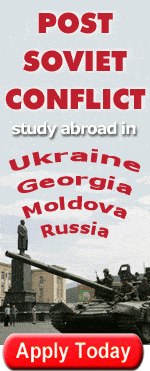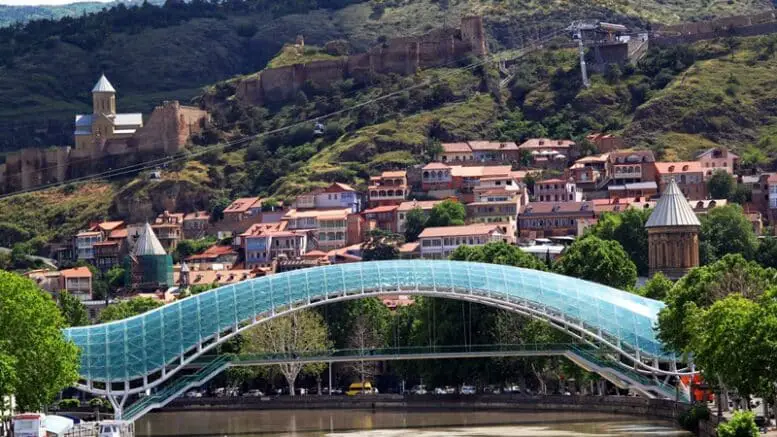These days, a visitor to Tbilisi might be struck by the calm, southern European atmosphere that pervades this hilly capital. The old city of Tbilisi, with its picturesque winding lanes, old buildings, and famously decorative balconies leaves an indelible impression of calm, comfort, and civilization. However, the cit
y was not always so. Since its founding, the city of Tbilisi has had a capricious fate – one that could rival that of any major city; it has plummeted from golden age to utter ruin and back again with great rapidity over the course of its long history. Indeed, the city can be best described as a survivor, a living being that has overcome its many conquerors and turned a corner to begin a new chapter of life.

A map of Georgia, including the disputed lands of South Ossetia and Abkhasia.
History of Tbilisi
According to legend, the city of Tbilisi was first founded in the mid-5th century by King Vakhtang Gorgasali, who encountered numerous hot springs while hunting in the area and was so impressed by them he decreed that a new city be built on the site. Thus the city received its name, Tbilisi, meaning “a warm place” in Georgian. As is the case with many ancient cities, archaeological records which show that the area around Tbilisi was inhabited well before it’s “official founding by a great ruler. The area was, in fact, likely inhabited as early as the 4th millenium BCE. Yet it does seem that King Vakhtang greatly enlarged whatever settlement was already present, and his son later established it as the new capitol of his kingdom. Due to its strategic location on major trade routes, Tbilisi swiftly began to grow and prosper, yet its growing wealth attracted attention from abroad.

This golden age ended abruptly in the 13th century with the arrival of the Mongols, and Tbilisi was conquered and sacked first by the Khwarezmians and then by the Mongols themselves in rapid succession. The city was devastated. While the Mongols were eventually expelled, for several centuries to come Tbilisi would see little peace as it was frequently attacked by invaders such as the Timurids, Turkmen, Persians, and Ottoman Turks. While Georgia remained nominally independent throughout all of this and the Kings of Georgia fought ceaselessly to protect their kingdoms, it gradually became evident that Georgia simply could not adequately defend itself alone.
Under the 1783 treaty of Georgievsk, Russia promised to protect Georgian autonomy, but Tsar Paul I instead annexed the land in 1800. Tbilisi was made the center of the new Tbilisi Governorate. While no longer an independent capital, Tbilisi remained an extremely important city, becoming the main economic, cultural, and administrative center of the Russian Caucasus. New roads and railroads were built connecting Tbilisi to the rest of the Russian Empire and the city began to acquire a new, more European culture and architecture which contrasted with the more Byzantine and Persian trends of previous centuries.
After the Russian Revolution in 1917, Tbilisi was briefly the capitol of the independent Democratic Republic of Georgia, yet this quickly collapsed in 1921 when occupied by Bolshevik armies. Georgia was incorporated into the new Soviet state, first as the capitol of the Transcaucasian SFSR and then, in 1936, as the capitol of the Georgian SSR. During the Soviet period, Tbilisi continued to grow. Far away from the fighting of WWII, Tblisi came to host several factories moved from Ukraine and Russia. Much of the city’s current aerospace industry, for instance, was once housed in Ukraine before being evacuated to Tblisi. The Soviets constructed a metro system and made the city a major center for higher education in the Caucasus.

After the Rose Revolution, Tbilisi residents saw some improvements in their situation as city infrastructure was repaired and a major government effort curbed corruption and organized crime. Tbilisi’s economy gradually grew and unemployment rates declined, though this process was slow and in part hampered in part by a Russian embargo enacted in 2006 on Georgian wines in light of rising tensions between the two states over separatist regions in Georgia. This embargo which was later expanded to include mineral water and some agricultural products, though negotiations are currently ongoing to end it. While residents of Tbilisi enjoy a standard of living far above that of the rest of the country, many continue to be unsatisfied with the situation in the city and the actions of the government, leading to civil unrest and large demonstrations against the Saakashvili regime.
Tbilisi Today
Today, Tbilisi is a dense city of approximately 1.5 million people lying on both banks of the Kura River. Old Tbilisi, the tightly packed core of the city, is home to the city’s old medieval churches and atmospheric old homes with decorative balconies for which the city is known. Elsewhere, up and coming neighborhoods like Vake are home to modern high-rises and expensive apartment buildings, while many of the cities further suburbs are filled with poorly maintained high-rises like those of every other post-Soviet city. The city is stitched together with a small two-line metro system as well as an expansive network of buses and private vans. While Tbilisi’s metro fell into disrepair after the fall of the Soviet Union, it has been largely restored to good condition and there are plans to add a third metro line through the Vake district, greatly expanding the metro’s range.
While Tbilisi’s population was in fact more Armenian than Georgian at the beginning of the 19th century, under Russian control the population gradually became more Georgian, a process that accelerated following the collapse of the Soviet Union. At present, approximately 85% of the population is Georgian, with only 7% Armenians. While the city formerly had a significant minority of Russians, these have largely left following the collapse of the Soviet Union and the Russo-Georgian War in 2008. Tbilisi remains a diverse city, with communities of other Caucasian peoples, as well as Greeks, Germans, Jews, Assyrians, and Estonians.
Apart from being the capitol, Tbilisi is also the intellectual center of Georgia, home to a number of state universities. The most prominent of these is Ivane Javakhishvili Tbilisi State University, which was became the first university in Georgia upon its founding in 1918 during the short-lived Georgian Democratic Republic. Numerous technical and specialized universities also add to Tbilisi’s pool of well-educated workers. Despite this wealth of talent, Tbilisi’s economy was quite stagnant during the later Soviet period, though it did see significant improvement in infrastructure and quite a bit of new construction up into the early 1960s. Tbilisi’s economy suffered greatly after the collapse of the Soviet Union, as infrastructure deteriorated and crime and corruption made economic activity difficult. Since the Rose Revolution in 2003, Tbilisi’s economy has taken off, largely based on transit infrastructure and trade across Georgia. Tbilisi’s strategic location on major trade and pipeline routes has also attracted numerous foreign banks; banking is now the second-largest sector in Tbilisi’s economy. All of this foreign investment has resulted in a construction boom, making construction and real estate the largest sector of the economy at present. Tourism is also on the rise, easily marketed on Georgia’s long history, traditions of hospitality, and, of course, the legendary Georgian wine and cuisine. Tourism promises to be an important part of the city’s economy in the future as more infrastructure is constructed.
Apart from its commercial pull, Tbilisi is also the spiritual center of Georgia. The archbishopric of Tbilisi-Mtskheta is considered to be the senior archbishopric of the church, and thus the residence of the Katholikos, the head of the church. The present Katholikos, Ilia, currently resides in Tbilisi, and has not hesitated to involve himself in civic life, making statements and appearances at times of civil unrest. In addition to the the Katholikos, the city also houses a number of well-known churches such as the Sameba Cathedral, Sioni Cathedral, and the Anchiskhati Church which draw pilgrims from all over the country.
Overall, present day Tbilisi is an interesting mix of modern commerce and Caucasian tradition, and is rapidly changing as the country modernizes and the economy expands. The city will undoubtedly be quite different in a decade’s time, and a visitor now will find a Tbilisi far different from the decrepit city of only a few years ago.




